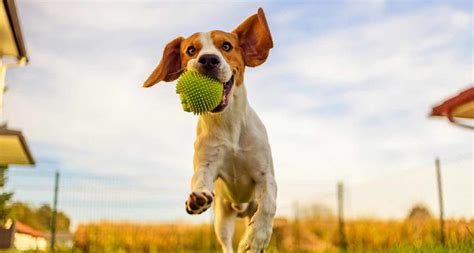Understanding the Importance of Exercise and Nutrition for Dogs
Dogs are our furry companions that bring immense joy into our lives. Ensuring their well-being is crucial, and a significant part of this involves providing adequate exercise and nutrition. This article will delve into the importance of both exercise and nutrition for canine health, exploring their benefits and potential consequences if neglected.

Exercise: The Key to a Healthy and Happy Dog
Exercise is a fundamental aspect of a dog’s life. It provides numerous physical, mental, and emotional benefits:
- Improved Cardiovascular Health: Exercise helps strengthen the heart and lungs, reducing the risk of cardiovascular diseases.
- Weight Management: Regular exercise prevents obesity, a common problem among dogs, which can lead to various health issues.
- Reduced Joint Pain: Exercise keeps joints flexible and mobile, alleviating pain and improving mobility, especially in older dogs.
- Improved Mental Well-being: Exercise releases endorphins, which have mood-boosting effects, reducing anxiety and stress.
- Behavioral Benefits: Exercise provides a healthy outlet for dogs’ energy, preventing boredom and destructive behaviors.
Recommended Exercise Regimens
The amount of exercise a dog needs varies depending on its breed, age, and overall health. A general guideline is to provide:
- Puppies: Short, frequent play sessions throughout the day.
- Adult Dogs: 30-60 minutes of moderate-intensity exercise (e.g., brisk walking, jogging) daily.
- Older Dogs: Lower-intensity activities like swimming or light walks as tolerated.
Nutrition: Fueling Your Dog’s Body and Mind
Nutrition is equally important for dogs’ health and well-being. A balanced diet provides the essential nutrients and energy they need to function optimally:
- Growth and Development: Proper nutrition supports healthy growth in puppies and maintenance of body weight in adult dogs.
- Energy Production: Dogs rely on carbohydrates, proteins, and fats as energy sources.
- Immune Function: Vitamins and minerals strengthen the immune system, protecting dogs from infections and diseases.
- Healthy Skin and Coat: Essential fatty acids and vitamins promote skin and coat health.
Recommended Dietary Guidelines
The ideal diet for a dog depends on factors such as age, activity level, and health status. Consult with your veterinarian for personalized dietary recommendations. However, some general guidelines include:
- Protein: 18-25% of calories from high-quality protein sources.
- Carbohydrates: 30-50% of calories from digestible carbohydrates for energy.
- Fats: 10-15% of calories from healthy fats for energy and nutrient absorption.
Striking the Optimal Balance
While exercise and nutrition are both crucial for canine health, finding the right balance is essential. Over-exercising or underfeeding can lead to adverse consequences:
Over-Exercising
- Muscle Strain and Injuries: Pushing a dog’s physical limits can cause muscle damage, sprains, and even fractures.
- Exhaustion and Dehydration: Excessive exercise without adequate rest and hydration can lead to fatigue and heatstroke.
- Reduced Immunity: Over-exercised dogs may have a weakened immune system, making them more susceptible to infections.
Underfeeding
- Weight Loss and Malnutrition: Insufficient food intake can result in weight loss, weakness, and nutrient deficiencies.
- Delayed Growth: Puppies need adequate nutrition for proper growth and development.
- Increased Risk of Health Problems: Malnutrition can weaken organs and increase the risk of diseases.
Effective Strategies for Balancing Exercise and Nutrition
Striking the right balance between exercise and nutrition requires a holistic approach:
- Consult a Veterinarian: Consult with your veterinarian to determine the optimal exercise and nutrition plan for your dog based on its individual needs.
- Gradual Exercise Increase: Gradually increase the duration and intensity of exercise to allow your dog’s body to adapt.
- Monitor Your Dog: Observe your dog’s behavior and energy levels to adjust exercise and food intake as needed.
- Provide a Variety of Activities: Offer a mix of activities to keep your dog physically and mentally stimulated.
- High-Quality Nutrition: Invest in high-quality dog food that meets your pet’s nutritional requirements.
- Regular Vet Check-Ups: Schedule regular veterinary check-ups to ensure your dog’s health and progress.
Tips and Tricks for Dog Owners
- Turn Exercise into a Bonding Experience: Make exercise time a fun and interactive activity for both you and your dog.
- Incorporate Exercise into Daily Routine: Integrate short walks or play sessions into your daily routine to maintain consistency.
- Reward Positive Behavior: Use treats or praise to encourage your dog’s participation in exercise and mealtimes.
- Monitor Water Intake: Ensure your dog has access to fresh water before, during, and after exercise.
- Avoid Overfeeding: Measure your dog’s food portions carefully to prevent weight gain and obesity.
Market Insights: The Future of Dog Exercise and Nutrition
The pet industry is constantly evolving, with advancements in products and services aimed at improving dog health and well-being. Here are some key market insights:
- Personalized Nutrition: The trend towards customized dog food based on individual needs is expected to continue.
- Smart Dog Products: Wearable devices that track activity and nutrition are gaining popularity, providing valuable insights into dogs’ health.
- Dog Exercise Apps: Mobile applications offer personalized exercise plans and motivation for dog owners.
- Increased Focus on Senior Dogs: The rising number of older dogs drives demand for specialized exercise and nutrition products.
- Sustainability and Eco-Friendly Options: Pet owners are becoming more environmentally conscious, leading to a demand for sustainable and eco-friendly dog products.
Conclusion: The Importance of Dog Exercise vs. Nutrition
Exercise and nutrition are interdependent pillars of canine health and well-being. Striking the right balance between these two factors requires a holistic approach, involving veterinary consultation, gradual exercise increase, monitoring, and high-quality nutrition. By prioritizing both exercise and nutrition, dog owners can ensure their furry companions live long, happy, and healthy lives. Remember, a healthy dog is a happy dog, and investing in their well-being is an investment in their love and companionship.





















